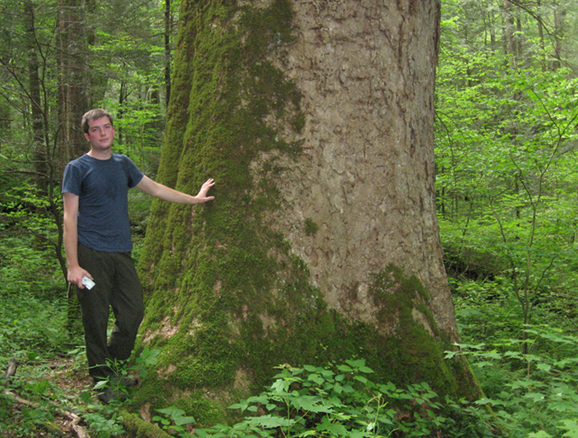Two of these trees are probably the oldest living things in the New York metropolitan area. The Alley Pond Park Giant in Queens is more than 135' tall and possibly as much as 450 years old. The Clove Lake Colossus on Staten Island is more than 120' feet tall with a more massive trunk**. The oldest known specimen was discovered near Forge Creek in the Great Smoky Mountains National Park; its age is estimated to be over 500 years--thus getting its start around the time of Columbus' voyage to the New World in 1492.
Large, beautiful flower of L. tulipifera
Leaf and bark
The tulip tree makes a stately landscape specimen in deep, well-drained loam rich in organic matter. Grown in full sun, it does not attain maximum height; this is a result of its shade intolerance, so the tallest specimens are found in forests reaching for the sun. There are several cultivars, some of which are relatively diminutive, such as 'Ardis Dwarf', a mere 12-18' tall, for smaller spaces; there is also a fastigiate (narrow columnar) form. Because of its beauty, it has been introduced in many parts of the world, including west of the Mississippi River outside its natural range in North America.
Young specimen showing brilliant fall color
The species is a major honey tree, producing a strongly flavored reddish honey much loved by bakers, but which gets mixed reviews as a table honey. The soft, fine-grained wood of tulip trees is known as poplar or yellow poplar in the states, but marketed abroad as "American tulipwood" other names. It is very widely used where a cheap, easy-to-work and stable wood is needed. It is the wood of choice for use in organs and commonly used for siding clapboards. Its wood may be compared in texture, strength, and softness to white pine. It has also been used for the interior finish of houses, for siding, for panels of carriages, for coffin boxes, furniture stock, veneer, pulpwood, and wooden ware. It has a reputation for being resistant to termites, and in the Upland South (and perhaps elsewhere) house and barn sills were often made of tulip poplar beams.
The fruits provide food for squirrels in the late fall and winter months, and white-tailed deer often browse on the twigs.

Massive trunk of mature specimen near Forge Creek in Great Smoky Mountains NP
Photo copyright: Neil Pederson
**See http://www.nytimes.com/2000/11/10/arts/a-rendezvous-with-2-giants.html


No comments:
Post a Comment